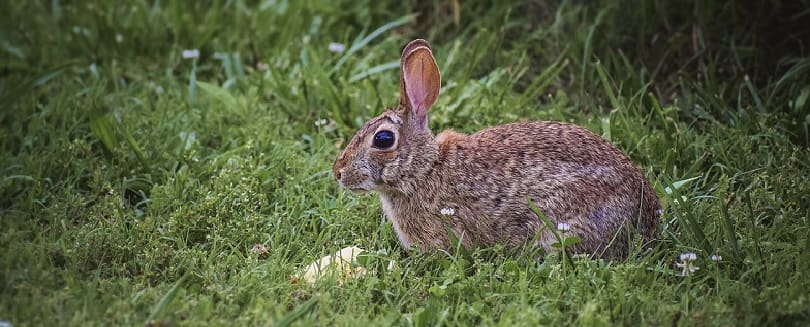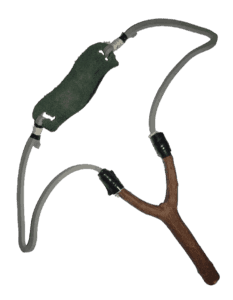Humans have been using clubs, spears and other primitive tools to hunt game and defend themselves since the dawn of time.
And while the steady march of progress has rendered many of these tools obsolete, a few have stood the test of time and retain their value for modern survivalists.
The slingshot is a great example of such a tool, and whilst it may not offer the value of a firearm, it can certainly help you survive some difficult situations.
Below, we’ll discuss the benefits and uses of slingshots, and provide some tips for choosing a high-quality product or making your own DIY version.
The Benefits of a Slingshot: An Ideal Survival Tool
Despite their ancient origins – modern slingshots were only made possible following the invention of vulcanized rubber in the middle of the 19th century, but primitive slingshots have been used in military applications since at least the 2nd century .
Slingshots are valuable tools for survivalists because they are:
Lightweight: This means they are easy to carry.
Simple: Don’t require extensive training to use.
Inexpensive: They are easy to fit into most survival-tool budgets.
Silent: Which makes them superior to firearms in some situations.
Multi-functional: This means they are helpful for solving a variety of problems.
Compatible with a variety of different ammunition: You needn’t worry about running out of ammo.
Primary Uses of a Slingshot
Slingshots can be used for a variety of purposes, including the following:
Hunting

Hunting is the most common purpose for which slingshots are used, and it’s easy to see why: Slingshots are stealthy, lightweight, easy to use and effective for taking small game.
While they lack the range of firearms, bows and other hunting tools, their small size and silent nature make them well-suited for hunting rabbits, rodents and birds at close range.
Self-Defense
While you certainly don’t want to bring a slingshot to a gunfight, wrist rockets can serve as reasonably effective self-defense tools in some cases.
Once again, their small size, portability and quiet nature make them effective for deterring threats at close to moderate distances.
Hanging Lines

There are a variety of reasons you may need to hang a rope or string in a tree. You may need to elevate your food bag to keep it safe from bears and raccoons, or you may need to stash supplies high in the tree canopy.
You may even need to hang ropes from a tree to provide support for your shelter. But unfortunately, it is often difficult to toss a rope up into a tree effectively.
However, if you tie a piece of cordage to a projectile, you can easily use your slingshot to help hang a rope from a tree.
Just use an arcing trajectory and aim a few inches above your target branch. With a little practice and patience, you’ll be able to send the projectile – and the attached rope – up and over the branch.
Arborists and tree pruners use this trick all the time.
Sending Messages
Slingshots can be helpful for sending messages across impassable obstacles, such as rivers or canyons.
Simply attach a small note to a projectile and send it on a high-arcing path toward the target area.
Just be sure to use caution so you don’t injure the people with whom you are trying to communicate, and be sure they are expecting the projectile, so they can seek cover.
Manipulating Game
With a bit of forethought and a few well-placed projectiles, it is often possible to spook game animals, causing them to move toward you or into a waiting trap.
For example, you could send a projectile over the head of a squirrel so that it crashes into the bushes behind him. This will usually send him sprinting in your direction, where you will be waiting to take advantage of an easier shot.
How to Hunt with a Slingshot
Hunting with a slingshot is a fairly straightforward pursuit, but you must follow a few rules and guidelines to have a good chance of success.
Stick to small prey
Although they require much greater accuracy to hit, small animals are more appropriate for slingshot-equipped hunters than large animals are.
Few slingshots pack the power to stop a deer or pig in its tracks; they’ll usually do nothing more than wound the animal. This should be avoided at all costs, so stick to squirrels, rabbits, rats, birds and similar prey.
Watch the video below to see small game hunting in action.
Emphasize stealth
Slingshots are only effective at relatively close range, and you’ll usually want to creep to within 20 or 30 yards of your quarry before releasing a projectile. To get this close to a squirrel or bird, you’ll need to move slowly and quietly to avoid spooking your prey.
Aim for your prey’s head.
Slingshot pellets rarely penetrate very far, so they kill via blunt force trauma.
Accordingly, you’ll want to aim for the head of the animal in your sights, rather than its body.
Headshots require much more accuracy than body shots, given the smaller target area, but they are typically lethal, while body shots will only wound the animal.
Watch this in-depth video if you want to learn more about how to aim your slingshot:
Important Features in a Slingshot
While there are many commercial slingshots on the market, they differ widely in terms of quality, price, and features.
It pays to be a discriminating shopper, which will help you get the most value for your survival-gear dollar.
Generally speaking, this means selecting a slingshot that possesses the following features and characteristics:
Sturdy frame materials: Slingshots are made from a variety of different materials, but properly treated hardwoods, polycarbonate and aluminum are the preferred choices.
Multiple bands: A slingshot will work with only a single band on each side of the frame, but multiple bands provide more power and spread the stress out across several different bands, which will prolong their life.
An attached wrist brace. Most modern slingshots come with an attached wrist brace, which helps to keep the slingshot stable and improve accuracy.
High-quality stitching. You don’t want the pouch to come free of the surgical tubing, so stick to well-made slingshots, with secure attachment points.
Magnetic ammunition holder. Although not strictly necessary, a magnetic ammunition holder will enable you to reload your slingshot and fire projectiles more quickly. Obviously, this isn’t very important for those who plan on using ammunition made from wood or some other non-magnetic material.
Aiming guides. A few modern slingshots are equipped with laser guides to help improve your accuracy and make it easier to hit your target.
Buy a Slingshot or Make Your Own?

Slingshots, like most other primitive weapons, are relatively easy to make.
Of course, DIY slingshots are unlikely to be as accurate as commercial versions, but with a little effort during the construction process and plenty of practice, once you’ve completed it, a homemade slingshot can be an effective tool for acquiring food and defending yourself.
Most of the components of a slingshot are easy to acquire:
You can find a sturdy Y-shaped stick, a bit of leather (although any strong fabric would work in a pinch) and a few feet of cordage just about anywhere. However, you’ll also need to use something for the bands, with surgical tubing being the ideal choice.
Surgical tubing will likely be hard to find in a SHTF situation.
Some of the better first aid kits may include a few feet of tubing, but there aren’t many other reliable sources for the material. Inner tubes can be used instead of surgical tubing, but they aren’t quite as effective.
Accordingly, many survivalists and preppers like to keep a few feet of surgical tubing in their bug out bag.
Surgical tubing is inexpensive, (Amazon Link) lightweight and doesn’t take up much space, so there are few downsides to throwing a bundle in your pack. Additionally, surgical tubing can be useful for other applications, such as making a tourniquet.
DIY Slingshot
It is important to know how to make a slingshot in case you find yourself in a difficult situation and in need of a weapon or hunting tool, but it is also fun to make a slingshot with your own hands.
While the process is fairly simple and straightforward, the entire project will take you several hours (even if you “cheat.”)
Materials
First, gather all of the things you’ll need to make the slingshot. This includes:
A Y-shaped stick
A length of surgical tubing
A piece of leather for the pouch
Some strong string (dental floss works well)
A saw
A knife
Procedure
- Locate a Y-shaped stick if you don’t already have one on hand. It should be about 1-foot-long (you’ll trim it down later), and the forked ends should be at least 30 degrees (one-third of a right angle) apart from each other. Be sure to select a very sturdy stick – oak, dogwood, hickory and ironwood are among the best woods from which you can choose.
- Trim the stick as necessary with your saw and then dry it out. The moisture present in the wood will make the slingshot flexible, which will compromise its strength and stability. Just letting the stick sit in a warm, dry room for a year or so will work, but you can also put it by a fire for a few hours and nuke it in the microwave for about 30 seconds at a time, until it stops hissing (wrap it in a towel first to help prevent fires and wick out the moisture).
- Cut a notch at the end of each arm of the slingshot frame. This will give you a secure place to attach the surgical tubing. Don’t make the notch too deep, as it may weaken the attachment point. Just make a small nick in the wood to keep the tubing in place.
- Cut the tubing into two separate pieces. Most people will find 12-inch-long lengths to be about right, although you should tailor the length to suit your arm length. Just remember that the shorter the bands, the faster they’ll fire a projectile. You’ll want to cut the tubing longer than you need so you have enough material to attach the tubing to the frame and leather pouch, so don’t trim it too short – you can always remove more material later.
- Wrap the tubing around each arm of the frame. Tie the bands in place using the dental floss.
- Cut a hole through each side of the leather. Thread each length of tubing through the hole on either side of the pouch. Double the tubing back up against itself and tie it in place with the dental floss.
- Gently test the slingshot a few times to ensure it is strong enough. Once you are confident that the frame and bands are all securely attached, you can start practicing with your new slingshot.
You can see a slingshot being made in this video.
There are also plenty of great commercially manufactured slingshots on the market. We have included a couple of recommended ones below.
Slingshot Ammunition

Part of the beauty of a slingshot is that you can use just about anything small, hard and heavy as a projectile. Steel shot (Amazon Link) is the gold standard, but you can use a variety of other objects including:
Small rocks or pebbles
Acorns or tree nuts
Small hardware (nuts or bolts)
Formed clay pellets
Coins
Small seashells
Shotgun shell pellets
Small rubber balls
Obviously, none of these projectiles will perform as well as steel shot, and they’ll all exhibit different flight characteristics.
However, you can learn to account for these differences with practice, so be sure to take your slingshot and a variety of different projectiles into the backyard for a bit of practice so that you are ready to use whatever is handy.
Slingshot Safety and Laws
Understand that slingshots are not toys – they are weapons that require respect and care during use.
If you don’t use a slingshot properly and keep safety in mind, you could hurt yourself or inflict serious injuries on others.
Be sure to follow the safety rules listed below.
Check the field before releasing a projectile.
Regularly inspect the bands, arms and leather pouch for signs of cracking or weak points.
Wear eye protection whenever you use a slingshot.
Avoid firing near rocks or other hard objects that may cause the pellet to ricochet back toward you.
Do not allow children to use slingshots without supervision – they are potentially dangerous tools, not toys.
It is a good idea to go ahead an order a pack of replacement bands (Amazon Link) so that you never have to take chances with old, worn out bands.
They aren’t expensive at all, and you’ll feel better knowing that you have a backup set on hand.
It is also worth mentioning that you’ll want to make sure slingshots are legal in your area before heading out into the backyard to practice.
Laws vary from state to state (and they change from time to time), so be sure to check out the legal environment before making your purchase.
Wrap Up
As you can see, a slingshot is a very useful tool that can help you survive difficult situations.
Because they are silent, simple and lightweight, they make a great addition to any bug out bag. And because they’ll fire anything from steel shot to small rocks, you’ll rarely have to worry about running out of ammo.
You’ll usually be best served by purchasing a commercially manufactured slingshot, but you can always make your own in a pinch (just remember to stash a bit of surgical tubing in your pack).
Be sure to practice with your slingshot enough to become proficient in its use, and you’ll be better prepared to feed and defend yourself in a survival situation.







Good introduction… In my younger days i was a fair shot taking small game at distances up to 15 yards… didn’t have the modern elastomers that are available now… Used sections cut from old inner tubes…
I eventually transitioned to the equivalent of the spear gun… I whittled the stock and firing mechanism (a pin through the stock at right angles to the arrow. pull it down to release the projectile)… Higher degree of accuracy and an arrow allows you to tackle larger game. Simpler to make than a bow and easier to achieve proficiency in a short amount of time.
Either are easier and faster to learn than the classical sling, although both are less lethal than an atlatl.
im familiar with the slingshot, i was a good shooter wen i was a kid im out of practice now…